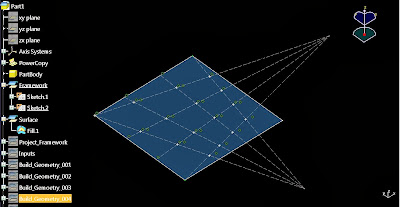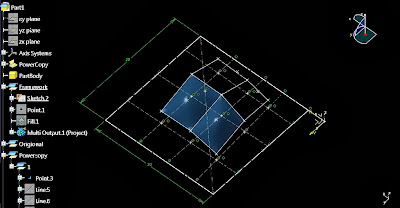Through the process of creating the powercopy which will be illustrated below, some geometrical issues emerged. In the first several attempts and after creating the powercopy, when starting the duplication process, the geometry flattened (the duplicated cell). So, one of the conclusions was, that the geometry of the cell - within the sketch - was over constrained. Another is that, the geometry was complex in nature and was being duplicated over another complex geometry - the surface's projected point. Based on both conclusions, the work frame and the powercopy that will be shown below will be relatively simple in geometry. The aim is to understand if the issue of complex geometry is the reason for the cell's flattening behavior.
Image 1: shows the framework - sketch.
Image 2: shows the filled surface. The surface's purpose is to guide the projected points from the sketch, so that they could guid the design in the three dimensional workspace. In addition, these points will help in positioning the cells onto their appropriate location when being duplicated.
Image 3: shows the projected points onto the surface, as mentioned in image 2.
Image 4: what follows the projected points is selecting the location for creating the first cell. In this case we have used four of the projected points to work with.
Image 5: shows the first smart cell (powercopy).
Image 6: shows the smart cells positioned onto their location based on the projected points.
Image 7: shows the duplication process. As mentioned previously, some geometrical problems have occurred. The issues of geometry still remind while duplicating the cells in this approach; working with a flat surface.
Image 8: the constant problem of cell flattening remind, as seen in the image (upper cell is a copy of the lower cell).
Image 9: this is one of the previous attempts to create the smart cell, using a curved surface. The creation of the cell and the first duplicate were successful, but any attempt to further duplicate the cell failed.










Comments
Post a Comment